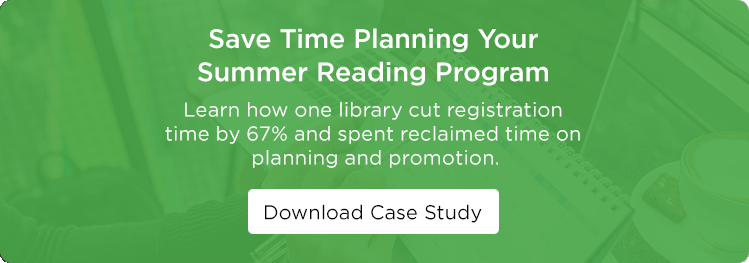
Summer Reading Program Planning Checklist
Even if your reading program is active for only three months of the year, you’re probably planning out across the other nine months. Year-round planning helps you optimize your time, eliminate last-minute emergencies and maximize the effort you put in so that your program is truly impactful. Since your other responsibilities don’t let up just because you have this big task ahead of you, we’ve developed a sample planning checklist that will set you up for summertime success.
Sample Planning Checklist
October
- Get your program management structure in place. Start with designating a program leader. This person will be responsible for overseeing the whole reading program project, from assigning to-dos to checking in with colleagues about assigned tasks and determining which actions to take next.
Then, depending on your library’s size, set up a planning committee or multiple committees — one for program finance, one for outreach and communication, one for activities and engagement, and one for reporting and measuring impact. Determine who will serve on which committee based on interests and skills. This will set you up to get buy-in from colleagues early on — the more support you have for your program, the more likely it will be a success!
- Set your program goals. This step has two important parts:
- Plan overarching program goals. If this isn’t your library’s first reading program, use performance data from previous programs for this. If you can’t base your goals off of participation and engagement numbers from the previous year, use your library’s most popular programs as a start and set a goal to meet or exceed those numbers. Be specific! For instance, you might aim to see a 5% increase in summer reading program registrations compared to the number of registrations for your most popular event last summer.
- Figure out what data you’ll need to collect to report progress toward your goal. If you use an online reading program management tool, you likely have a range of activities that you can track, from books to pages to minutes read. If you use an advanced tool like Wandoo Reader, you’ll even be able to track Challenges completed (fun activities that promote literacy and learning beyond reading books), prizes earned and prizes redeemed, as well as program completions (how many patrons achieved all of your program’s goals).
When you’re setting your program goals and determining what data you’ll need to show that you’ve met them, also spend some time planning how you’ll pull metrics and how often you’ll analyze them. Come up with mini-milestones throughout the summer, and think through contingency plans in case you’re not on track to meet your program’s goal.
- Plan your framework. Will you offer one all-inclusive program for all age groups? Or will you offer multiple programs — one for children, one for teens and one for adults? Here are some questions that will help you determine which framework works best for your library:
- What do your staffing resources look like? If you have limited support from staff, a single program will streamline logistics. Many libraries offer one program — that is, one theme with standard prize levels — but their prize categories correspond with participants’ ages. Not only will it be easier to set up a single program, but also staff won’t have to spend time memorizing different themes and prize structures. Sometimes simple is better.
- How many incentives do you have on hand? Take some time now to determine how many prizes you’ll offer readers. This can get complicated if you offer too many, but readers may be less inclined to participate in your program if you offer too few. Libraries we’ve worked with have seen success with going as simple as offering one prize for registration, one prize midway through the program and one prize for completion. Not only does this minimize staff time spent redeeming prizes, but it means you have to spend less time coordinating prize donations with sponsors as well.
- How robust is your program management tool? If you use Wandoo Reader, you’ll be able to have the best of both worlds. You can set one theme and have standard prize levels, and then you can create a different “program” for each age group within the tool. That way you can add more Challenges to the teen/adult programs and keep your children’s programs simple (since parents often log their children’s progress). You’ll also be able to customize registration questions so you can collect such information as what schools participating children attend. These data will come in handy as you strategize your school outreach for next year.
November
- Establish your theme. You have a variety of options when it comes to a theme. You could go with a mythology-inspired quest or a broader theme like music or art, or you could get trendy and play off of a motif that’s popular with kids these days. To get started, take a look at your usage and circulation stats. What types of books are most popular among each age group? See any theme ideas there?
- Draft your budget. Plan how much funding is necessary to put on the reading event of the year, and identify funding sources at this stage as well. Since most grant deadlines are in July or August, it’s too late to apply for grants for this year’s program — but it’s the perfect time to get started on your applications for next year’s program! Grant applications vary, but many ask that you answer these questions:
° What activities/programs are you planning on implementing?
° What population are you targeting with these activities/programs?
° How will you assess the impact of your activities/programs?
° What materials do you need to buy for these activities/programs?
° How much funding are you seeking?
Tip: Plan ahead when it comes to grants. Many grant deadlines are in July and August, so you’ll need to plan over a year in advance to count these in as sources of funding. Demco offers its free library and education grants database to help libraries like yours search for funding sources without having to budget for a database subscription. You’ll want to bookmark this grants search tool.
December
- Define sponsorship packages. What will your library offer businesses and organizations in return for their sponsorship? Many libraries include partner logos on their marketing materials and reading program webpages, mention their partners in a certain number of social media posts throughout the summer and/or allow businesses and organizations to provide prizes with their business logos on them. Check to see if your online reading program management tool allows for any other recognition. For example, Wandoo Reader offers libraries the opportunity to recognize their sponsors within the online tracking experience.
If you have numbers from last year’s reading program, use them to help you communicate the possible return on investment for potential sponsors. If you don’t have access to these numbers, convey the information you do have. For instance, how many people visited your website last year? How many attended your most popular event? Share the data with sponsors. This will give them a feel for how many community members will be exposed to their product or service if they partner with your library.
- Figure out potential sponsors and start your outreach. Does your community host an annual 5K or throw a big yearly festival? Look at your community’s event websites for inspiration and to learn about the events’ national and local sponsors. You can also get inspired by other libraries. Just Google “library summer reading program partnerships” and click around to see what types of businesses have partnered with libraries outside of your community. Their local equivalents might be just who you’re looking for when it comes to sponsors for your program.
January
- Develop your marketing and promotion strategy. When it comes to promoting their summer reading programs, many libraries start with the outlets they own, like their websites, seasonal program guides and newsletters. Start there and then expand. Tack flyers on bulletin boards at local coffee shops and other busy meeting places. Reach out to your local radio station about mentioning your program on one of their shows. Attend the local farmers market or art fair to pass out information about your program.
- Start creating marketing material. Your marketing and promotion strategy will dictate what you need as far as marketing materials go. Since you’ll want to be consistent when representing your program, plan to design all of your marketing materials, from digital ads to print pieces, around the same time.
February
- Finalize all marketing materials. Do a final typo check and get your final approvals from necessary stakeholders. These materials are going to get their moment in the spotlight next month.
- Schedule community visits. School outreach is an important part of your marketing and promotion strategy, and this is the month you should start reaching out to schedule visits. Spring will be heavy with field trips and exams, and you want schedule on a day when you can get in front of the largest audience possible. Plan to conduct school visits in March and April, but start the conversation about scheduling them now.
Consider other community spaces that may be willing to host you for a presentation about your program. Call around now to ask what days and times are best for a visit to churches, synagogues, mosques, retirement communities, teen centers, Boys & Girls Clubs, Scout meetings and the like.
March
- Finalize sponsors and collect all of your prizes. By now, you’ll want to finalize your list of sponsors so you know what they’re donating to your program. That way you have time to figure out how you’ll fill in any prize gaps.
- Open registration and start driving potential participants to sign up. It’s time to roll out those newsletter advertisements, post those flyers around town and get your tweets and social posts rolling.
Aim to give potential program participants at least one full month to register for your program, and heavily promote early registrations — think along the lines of “Register by May 1 for an exclusive sign-up prize!” This will give patrons more time to participate in the program, and it will help you spread out prize redemption, which your staff will appreciate. Not everyone will take you up on this head start, but those who do will appreciate the ample time frame.
April
- Put the finishing touches on your program and start your countdown to launch. Launch day is almost here! Spend this month addressing last-minute details, getting everything in order and preparing to use all the amazing marketing materials that you worked so hard on over the winter.
May–August
- Experience your best reading program ever! This should be quite easy to do since you’ve put in so much hard work already.
- Keep promoting your program. Even after your program launches, stay on top of your marketing and promotion plan. Now’s the perfect time to capture the attention of the busy families who didn’t have time to come into the library until summer break.
- Finalize and submit grant applications for next year’s program. Many grants have July and August deadlines, so you’ll need to plan a full year ahead if you’ll be relying on these as sources of funding.
September
- Measure program outcomes. Did you meet your goals? If yes, congratulations! Keep up the momentum as you plan how you’ll increase your program success next year. If not, this is a valuable learning opportunity. Take time to reflect on what didn’t work as well as you would have liked it to, and come up with an actionable improvement plan to get closer to your goal next year. Ask yourself such questions as the following:
° Do I need to expand my marketing? Think about ways that you can further engage the audiences you reached this year, but also consider other audiences that may be interested in hearing about your program. Perhaps you had a solid plan in place for reaching out to elementary school students, but you didn’t spend as much time on high school students. What do you need to do differently during your school visits next year?
° Was participating in the program seamless for patrons? Collect feedback from participants via an online survey. Be sure to ask them what they liked about the program, but also ask what they didn’t like so you can address any pain points next year.
° What additional participation incentives can I add? Review your prizes earned and prizes redeemed numbers as you consider this question. Were there many prizes earned but not so many redeemed? Maybe your prize redemption process is too confusing and patrons need clearer instructions on how to cash in on their hard work. Perhaps you also need to venture out of the library and offer patrons another location at which to redeem their prizes.
- Identify areas for improvement. What went well? What could go better? Collect feedback from participants and from your planning committee members. Then, refine your plan for next year’s summer reading program, which you’ll begin planning next month.
If you’re looking for even more ways to streamline your program, you’ll want to read how Joliet Public Library (IL) cut program registration time by 67%.




